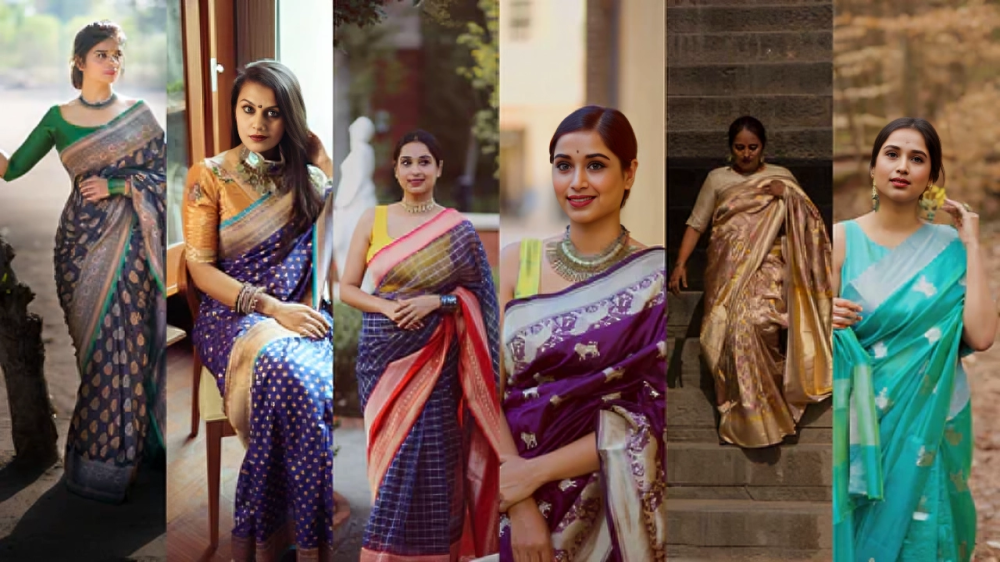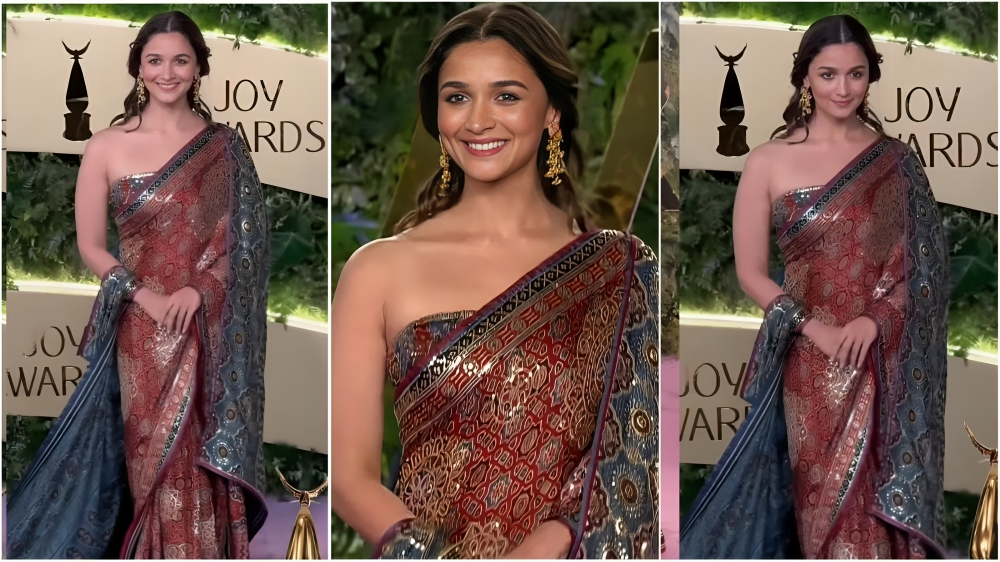The Trajectory of the Indian Saree

Image Source: DiscoverDiva
The unstitched 6 to 9-yard Indian Saree is an epitome of elegance and comfort, commanding high fashion in today’s world. It occupies a special place both in the hearts and almirahs of our mothers, celebrating women as desi girls. It sounds unreal how it stands firm today, undergoing an evolution right from the times of the Indus Valley Civilization to a camera-ready modern makeover. It has re-defined resilience being firm to the many forms of adaptations and exorbitant experiments.
A sophisticated saree with a corset blouse paired with nude lipstick and diamond jewelry is the new age aesthetic setting the saree trend free of any generational barrier. The saree has a long history dating back to ancient India when women wore it as a simple yet practical garment of clothing. In Sanskrit and Prakrit, “Sati” means “strip of fabric,” and this is where the word “saree” originates. The Mughals added brilliant embroidery and complex weaving, which plummeted its popularity. Rich Indian women began requesting that craftspeople use pricey stones and gold threads to create special saris for the affluent after outsiders arrived.

An exquisite form of the saree which evolved during this era was seen worn by Actress Alia Bhatt recently at the Joy Awards, Riyadh, namely the Ajrakh Saree. Ajrakh is a traditional hand block-printed fabric originating from the Kutch region of Gujarat with designs inspired by the fragments of Cairo. Bollywood and fashion have always gone hand in hand, even at the beginning of the industry. Bollywood movies have acted as a window into society, reflecting current events and influencing fashion decisions. Leading the way in this cinematic fashion revolution was the Indian saree, a staple of the nation’s cultural identity.

The golden era of Bollywood, marked by the likes of icons such as Madhubala, Meena Kumari, and Nargis, showcased a glamorous and sophisticated portrayal of the saree. Actress Rekha of this marvelous period is known for perfecting her evergreen look of a Kanjivaram Saree with a Gajra and Sindoor. She believes it to be an invaluable memento from her mother, “When I wear a Kanjeevaram sari, I feel like I’m engulfed in her love,” says Rekha. In keeping with the modernity of the swinging sixties and seventies, Bollywood changed the saree to suit the times.
Lightweight, colorful sarees with striking designs and avant-garde draping were first popularized by the youth-focused films of that era, which starred actors like Mumtaz and Sharmila Tagore. The younger generation found the saree more enticing as it became more versatile and approachable. Raveena Tandon and Sushmita Sen’s georgette sarees in ‘Tip Tip Barsa Pani’ and ‘Main Hoon Na’ revolutionized the wave of saree, from being the top choice of girls in their farewells to being the bestseller in the markets.
The Indian saree has had an intriguing transformation in the twenty-first century, fusing current style with heritage. Bollywood’s ever-changing fashion continues to have an impact on current saree trends. Priyanka Chopra, Sonam Kapoor, and Deepika Padukone are a few of the actresses who have revolutionized saree design by experimenting with modern silhouettes, fusion styles, and unusual draping. The red carpet events have evolved into a platform for exhibiting the Indian saree’s flexibility, both domestically and abroad.
By producing avant-garde saree costumes, pre-stitched sarees, and unusual blouse styles, designers are pushing the envelope. Once limited to traditional events, the saree is now making a big impression on the world of fashion. Handwoven sarees that are environmentally friendly are becoming more and more popular, following the world’s trend towards sustainability. Traditional weavers and designers are working together to develop sarees that are not only gorgeous to look at but also made in an ethical manner.
The rise in popularity of handloom sarees is indicative of a growing admiration for skillful workmanship and a dedication to safeguarding India’s abundant textile legacy. Fashion has become more accessible in the digital era, and social media saree influencers have been instrumental in showcasing a variety of saree looks. Creators like Komal Pandey, Kritika Malik, and so on are at the forefront of the saree buzz, captivating the GenZ mass with their one-of-a-kind styling statements. For those who love sarees, Instagram, in particular, has developed into a virtual runway that features everything from modern drapes to antique weaves.
Online marketplaces have facilitated the exploration and acquisition of sarees from various regions, helping in the resurgence of local textile customs. The saree has not stepped back in absorbing and learning from the west. Corsets being worn as a blouse with the saree is one of them, making it to the charts of glam trend. The saree has transcended beyond Oprah’s couch on a global scale, as celebrities have glamorized them as haute couture and worn them on red carpets. They might be political opposition or political propaganda at different times.
Additionally, they are the sentimental heirlooms that assist contemporary young ladies in honoring a treasured past, with hashtags like #100sareepact and #sareeaday. The Indian subcontinent’s diverse cultural influences have molded the saree over its extraordinary, centuries-long history. Its troubled past has faded into obscurity, but even in this new decade of technological advancement, it is still widely accepted by even the most contemporary women in the subcontinent, and despite the garment’s limited capacity for change, it appears to have an endless future.
The saree continues to be a vibrant and timeless representation of Indian femininity and style, from the royal elegance of the golden age to the modern fusion designs of today. The saree’s ability to change with the times while maintaining its classic appeal is evidence of its lasting influence in the fashion industry as we embrace the future.
Author
Mudit Aggarwal is a second-year student pursuing Media and Journalism Honours at Christ University (Deemed to be University), Bengaluru.
Team Profile

Latest entries
 Education31 October 2025दिल्ली स्कूल ऑफ जर्नलिज्म, दिल्ली विश्वविद्यालय ने आयोजित की 9वीं व्याख्यान श्रृंखला: “भारतीय मन की पुनर्प्राप्ति”
Education31 October 2025दिल्ली स्कूल ऑफ जर्नलिज्म, दिल्ली विश्वविद्यालय ने आयोजित की 9वीं व्याख्यान श्रृंखला: “भारतीय मन की पुनर्प्राप्ति” Article13 October 2025Ms. R.V. Honeyshya Raj Decodes Judicial Clerkship in a Mentorship Programme at Campus Law Centre
Article13 October 2025Ms. R.V. Honeyshya Raj Decodes Judicial Clerkship in a Mentorship Programme at Campus Law Centre Education10 October 2025“Geopolitics Is All About Leverage”: Maj. Gen. Ranjan Kochar Explores Global Power Dynamics at DSJ, University of Delhi
Education10 October 2025“Geopolitics Is All About Leverage”: Maj. Gen. Ranjan Kochar Explores Global Power Dynamics at DSJ, University of Delhi Education26 September 2025AI in Newsrooms: JNU Scholar Dr. Shubh Gupta Urges Ethical, Informed Use of Technology in Journalism at DU Lecture
Education26 September 2025AI in Newsrooms: JNU Scholar Dr. Shubh Gupta Urges Ethical, Informed Use of Technology in Journalism at DU Lecture











